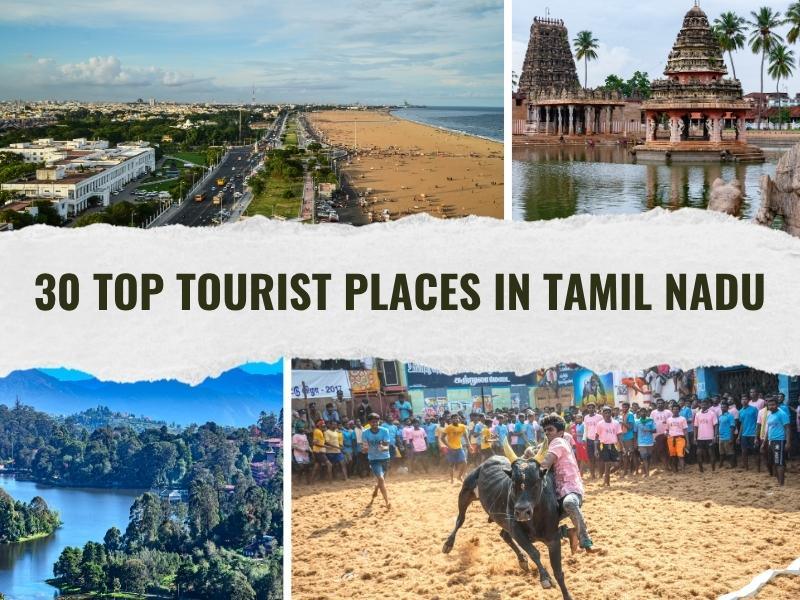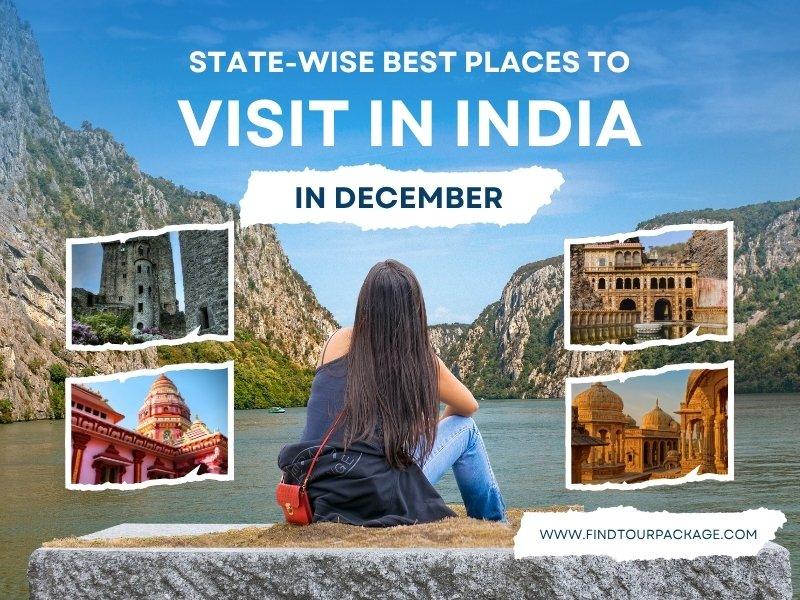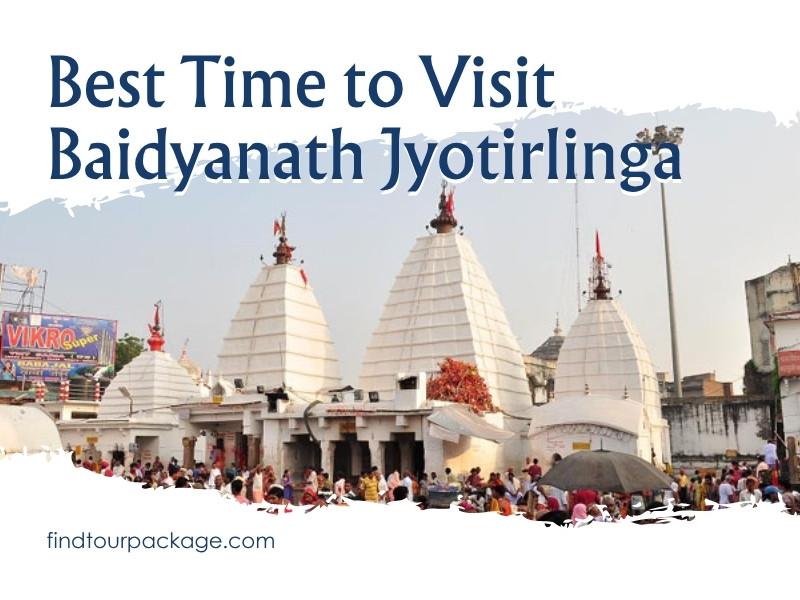Top Tourist Places in Tamil Nadu: Tamilnadu, located along India’s southern coast, is cherished for its striking temple towns, lush hill stations, and scenic coastline. The state radiates a unique charm through its rich culture, vibrant markets, and deep-rooted traditions, making every journey here a discovery.
Travelers adore Tamilnadu for its ancient Dravidian architecture, buzzing pilgrimage routes, and sun-kissed beaches. The aromas of jasmine and filter coffee fill the air, and colorful festivals offer heartwarming spectacles. This article serves as your hands-on Tamilnadu Travel Guide, showcasing practical tips and the Top Tourist Places in Tamilnadu for every itinerary.
Quick Facts & Snapshot
Tamil Nadu, located at the southernmost tip of India, is a state rich in Dravidian heritage and natural beauty. It attracts millions of visitors annually who come to experience its magnificent temples, bustling markets, serene beaches, and lush plantations. The state capital, Chennai, serves as the primary gateway for most travelers arriving by air or rail.
The best time to visit Tamil Nadu generally falls between October and February when temperatures remain pleasant and humidity levels drop. You’ll encounter warm, tropical weather during the monsoon season from June to September, while summers from March to May can be quite intense. Budget-conscious travelers can explore Tamil Nadu comfortably on ₹1500 to ₹3000 per day, while mid-range travelers should allocate ₹4000 to ₹8000 daily.
| Fact | Detail |
|---|---|
| Best Time to Visit | October to February (cool, dry weather) |
| State Capital | Chennai |
| Main Airport | Chennai International Airport (MAA) |
| Official Tourism Site | Tamil Nadu Tourism Website |
Also Read: Best Places to Visit India During Christmas Holidays
30 Must Visit Places & Hidden Gems in Tamil Nadu 2025
| No. | Place Name | Description |
|---|---|---|
| 1 | Chennai | Tamil Nadu’s capital offers Marina Beach, heritage architecture, vibrant temples, and delicious street food blending tradition with modern city life. |
| 2 | Madurai | Known as the Temple City, Madurai dazzles with the Meenakshi Amman Temple, colorful markets, and timeless Dravidian architecture. |
| 3 | Rameswaram | A sacred island destination famous for Ramanathaswamy Temple, Pamban Bridge, and serene beaches connecting mythological and spiritual heritage. |
| 4 | Kanyakumari | India’s southernmost tip where the Indian Ocean, Arabian Sea, and Bay of Bengal meet, offering mesmerizing sunrises and Vivekananda Rock Memorial. |
| 5 | Mahabalipuram | A UNESCO World Heritage site filled with rock-cut monuments, ancient Shore Temple, and beachside charm for history lovers and explorers. |
| 6 | Ooty | The Queen of Hill Stations known for its tea gardens, cool weather, toy train rides, and lush green valleys. |
| 7 | Kodaikanal | A misty hill town featuring lakes, pine forests, and romantic viewpoints perfect for couples and nature enthusiasts. |
| 8 | Coimbatore | Gateway to Western Ghats, offering temples, waterfalls, textile shopping, and nearby hill escapes like Valparai and Isha Yoga Center. |
| 9 | Thanjavur | Cradle of Tamil art and culture, home to the grand Brihadeeswarar Temple and exquisite bronze sculptures. |
| 10 | Trichy (Tiruchirapalli) | A historic river city known for Rockfort Temple, Srirangam’s vast temple complex, and a mix of spirituality and heritage. |
| 11 | Chettinad | Land of heritage mansions and spicy cuisine, showcasing Tamil Nadu’s architectural brilliance and culinary depth. |
| 12 | Yercaud | A serene hill station in the Eastern Ghats famous for its lake, coffee plantations, and misty viewpoints. |
| 13 | Chidambaram | Spiritual hub known for Nataraja Temple, dedicated to Lord Shiva’s cosmic dance and cultural dance festivals. |
| 14 | Hogenakkal Falls | Often called the Niagara of India, offering coracle rides, scenic views, and natural fish spa experiences. |
| 15 | Pondicherry | French colonial charm meets Indian spirituality with vibrant cafes, Auroville, beaches, and yoga retreats. |
| 16 | Dhanushkodi | A ghost town at Rameswaram’s tip, blending sea views, mythology, and abandoned ruins for a hauntingly beautiful visit. |
| 17 | Tiruvannamalai | A powerful spiritual destination home to Arunachaleswarar Temple and Sri Ramana Maharshi Ashram. |
| 18 | Valparai | Hidden hill station surrounded by tea estates, waterfalls, and wildlife, ideal for quiet escapes and photography. |
| 19 | Kumbakonam | Temple town known for its filter coffee, ancient shrines, and rich cultural heritage along the Cauvery River. |
| 20 | Nagapattinam | A coastal gem with pristine beaches, historic churches, and vibrant local fishing culture. |
| 21 | Courtallam | The “Spa of South India,” famous for rejuvenating waterfalls believed to have medicinal properties. |
| 22 | Vellore | Known for Vellore Fort, golden temple, and rich historical legacy surrounded by scenic hills. |
| 23 | Thiruvarur | Renowned for its ancient temples, musical traditions, and the massive temple chariot festival. |
| 24 | Pichavaram Mangrove Forest | Second-largest mangrove forest in the world, offering peaceful boat rides through dense green waterways. |
| 25 | Pollachi | A charming countryside near Coimbatore with coconut groves, waterfalls, and scenic drives toward Valparai. |
| 26 | Thiruchendur | Coastal temple town housing the famous Murugan Temple right beside the sea waves. |
| 27 | Coonoor | A picturesque hill station near Ooty, perfect for tea garden strolls and serene viewpoints. |
| 28 | Manapad | Hidden coastal village offering surfing spots, old churches, and peaceful blue waters. |
| 29 | Kolli Hills | Offbeat mountain retreat with hairpin bends, hidden waterfalls, and cool weather, loved by bikers and trekkers. |
| 30 | Pulicat Lake | A tranquil bird sanctuary near Chennai known for flamingos, lagoons, and scenic boat rides. |
How to Reach Tamil Nadu
Tamil Nadu is exceptionally well connected to major Indian cities through multiple transportation networks. Chennai, the state’s largest city and primary entry point, hosts Chennai International Airport which receives flights from across India and international destinations. The airport is located approximately 12 km from the city center, with a 30 to 40 minute drive to downtown Chennai under normal traffic conditions.
For rail enthusiasts, Chennai Central Railway Station and Chennai Egmore Railway Station connect the state to virtually every major city in India. Express trains from Delhi, Bangalore, and Mumbai arrive regularly, offering an economical travel option. The journey times range from 12 to 24 hours depending on your origin city. Long-distance buses operated by various state transport corporations provide affordable connectivity from neighboring states like Karnataka, Kerala, and Telangana.
Road connectivity to Tamil Nadu is excellent, with well-maintained National Highways connecting it to Bangalore (350 km), Hyderabad (550 km), and Kochi (450 km). If you’re planning to explore multiple destinations within the state, renting a vehicle offers maximum flexibility. Local taxis and auto-rickshaws are readily available in all major towns and tourist centers.
Top Gateways and Average Travel Times from Major Metro Cities:
- Chennai to Bangalore: 6 to 7 hours by road
- Chennai to Hyderabad: 8 to 9 hours by road
- Chennai to Coimbatore: 10 to 12 hours by road or 9 to 11 hours by train
- Kanya Kumari Airport serves the southern regions (180 km from Kanya Kumari)

Top 15 Best Places To Visit in Tamil Nadu
1. Meenakshi Temple, Madurai
The iconic Meenakshi Temple stands as one of India’s most magnificent temples and a masterpiece of Dravidian architecture. This ancient temple complex dedicated to the goddess Meenakshi has been a pilgrimage destination for over 2000 years and continues to enchant visitors with its ornate towers, intricate carvings, and spiritual atmosphere.
- Why it’s a must visit: The temple’s stunning gopurams (towers) are architectural wonders adorned with colorful sculptures and paintings that tell stories from Hindu mythology. This is an essential stop for understanding South Indian temple culture and experiencing authentic religious traditions.
- Key experiences: Participate in evening aarti (prayer ceremonies), explore the 1000 pillar hall, witness the daily flower offerings, or visit during April when the annual Chithirai festival celebrates Meenakshi’s marriage with elaborate processions and rituals.
- Practical tip: Entry is free. Best visited early morning (5:00 to 7:00 AM) to avoid crowds. Dress modestly and remove footwear before entering inner sanctums. Photography restrictions apply in certain areas.
2. Kanya Kumari Beach
Kanya Kumari, meaning “virgin goddess,” marks India’s southernmost point where the Arabian Sea, Indian Ocean, and Bay of Bengal converge. This mystical beach offers stunning sunset views and holds immense spiritual significance in Hindu tradition.
- Why it’s a must visit: Standing at the meeting point of three seas is a uniquely Indian experience that few travelers get to enjoy. The symbolic significance combined with breathtaking vistas makes this a bucket list destination for many visitors.
- Key experiences: Watch the spectacular sunset over the convergence of three seas, visit the iconic Vivekananda Rock Memorial, explore the Kumari Amman Temple, or take a boat ride to see the unique geographical phenomenon up close.
- Practical tip: Entry fee for Vivekananda Rock is ₹30. Ferry boats charge ₹50 to ₹100 per person. The best time to visit is during sunset, arriving at least one hour prior. Avoid visiting during monsoon when seas become rough and boats cease operations.
3. Ooty (Udhagamandalam)
Nestled in the Nilgiri Mountains at an elevation of 2240 meters, Ooty is a charming hill station offering cool climate, lush gardens, and misty landscapes. The town served as a summer retreat during British colonial times and retains much of its nostalgic charm.
- Why it’s a must visit: Ooty provides respite from Tamil Nadu’s tropical heat with pleasant temperatures ranging from 10 to 20°C throughout the year. The picturesque environment makes it ideal for nature lovers, couples seeking romantic getaways, and families wanting to escape urban stress.
- Key experiences: Ride the historic Nilgiri Mountain Railway, explore the spectacular Botanical Gardens featuring rare plant species, visit Doddabetta Peak for panoramic views, or trek through fragrant eucalyptus forests and tea plantations.
- Practical tip: The journey from Coimbatore to Ooty takes 4 to 5 hours by road (85 km). The mountain railway journey (5 hours, 46 km) is an unforgettable experience but books up quickly during peak season. Book train tickets 30 days in advance. Entry to Botanical Gardens costs ₹50.
4. Rameswaram
Rameswaram holds profound spiritual importance as one of the four sacred pilgrimage sites (Dhams) in Hindu mythology. This coastal temple town on Pamban Island offers a unique blend of religious significance, natural beauty, and maritime history.
- Why it’s a must visit: The Ramanathaswamy Temple houses one of the 12 sacred Jyotirlingas and features the longest temple corridor in India. Devotees undertake this pilgrimage to seek blessings and witness architectural brilliance that showcases South Indian temple construction.
- Key experiences: Explore the ornate corridors of Ramanathaswamy Temple with 22 sacred wells, visit Pamban Bridge for sunset views, relax on pristine Agni Theertham Beach, or undertake the spiritual circumambulation of the temple complex.
- Practical tip: Entry is free. The temple is crowded during full moon days and major festivals. Visit early morning or late afternoon for a more peaceful experience. The nearest railway station is well connected to Chennai (580 km, 14 hours) and Madurai (160 km, 4 hours).
5. Tiruvannamalai
Tiruvannamalai, home to the sacred Arunachaleswara Temple, stands as one of Tamil Nadu’s most spiritually significant pilgrimage destinations. The temple sits at the base of the Arunachala Mountain, a massive rocky outcrop that dominates the town’s skyline and holds deep spiritual significance in Hindu philosophy.
- Why it’s a must visit: Tiruvannamalai represents authentic Tamil spiritual experience where devotees circumambulate the sacred mountain and participate in temple rituals spanning centuries of unbroken tradition. The mountain’s towering presence creates a powerful atmosphere that transforms visitor perspectives.
- Key experiences: Trek around the 14 km sacred mountain circumambulation path (Girivalam) completed by pilgrims for spiritual merit, explore the magnificent Arunachaleswara Temple with its 11 tiered gopuram and intricate carvings, participate in evening aarti watching flames light the mountain peak, or visit the Sri Ramana Ashram dedicated to the famous saint.
- Practical tip: Entry to the temple is free. The Girivalam path is best completed early morning (3:00 to 6:00 AM) in cooler temperatures. Wear sturdy walking shoes and carry water. The town is 180 km from Chennai (4 hours) and 60 km from Vellore (1.5 hours). Visit during Kartik Pournami (November to December) when the summit lights up during evening celebrations.
6. The Nilgiris (Ooty and Surrounding Mountains)
The Nilgiri Mountains spanning Tamil Nadu’s western borders offer spectacular hill station experiences with tea gardens, cool climates, and mountain forests. This UNESCO Biosphere Reserve encompasses lush ecosystems featuring diverse wildlife and stunning biodiversity.
- Why it’s a must visit: The Nilgiris provide perfect escape destinations during Tamil Nadu’s hot months with temperatures dropping 15 to 20 degrees compared to plains. The misty mountains, winding roads, and abundant flora create enchanting environments for nature lovers and adventure seekers.
- Key experiences: Ride the historic Nilgiri Mountain Railway, trek through shola forests observing rare species like the Nilgiri tahr, visit Doddabetta Peak for panoramic views across three states, or explore the Botanical Gardens showcasing rare plant species and orchids.
- Practical tip: Ooty is 85 km from Coimbatore (4.5 hours) and accessible via the iconic mountain railway (5 hours, 46 km). The railway journey is highly sought after; book tickets 30 days in advance. Botanical Gardens entry is ₹50. Visit November to February for pleasant weather with clear skies ideal for photography.
7. Thanjavur
Thanjavur, the medieval capital of the powerful Chola Empire, is an open-air museum of Dravidian art and architecture. The city pulses with historical significance and remains a cultural heartbeat of South India.
- Why it’s a must visit: The Brihadeeswarar Temple with its gravity-defying stone dome represents the pinnacle of Chola architectural achievement and is recognized as a UNESCO World Heritage Site. The temple stands as a testament to ancient engineering brilliance that continues to astound modern architects.
- Key experiences: Marvel at the main temple’s granite dome and intricate sculptures, explore the thanjavur painting workshops displaying traditional art, visit the Royal Palace ruins, or participate in the annual Aadi Perukku festival celebrating the monsoon.
- Practical tip: Entrance fee is ₹50 (Indians) and ₹250 (foreigners). The best time to visit is morning when light illuminates the temple sculptures beautifully. Thanjavur is 56 km from Trichy Railway Station (1 hour drive). Hire a local guide for deeper historical insights.
8. Kodaikanal
Kodaikanal, meaning “gift of the forest,” sits at 2133 meters and offers a perfect blend of natural beauty, adventure opportunities, and peaceful retreats. This colonial hill station on the Palani Hills attracts nature enthusiasts and those seeking quiet mountain experiences.
- Why it’s a must visit: Kodaikanal provides stunning views of the surrounding valleys, dense shola forests, and a serene lake at its center. The cooler climate and misty mountain air create a rejuvenating atmosphere that contrasts beautifully with Tamil Nadu’s coastal plains.
- Key experiences: Trek to hidden waterfalls like Gundalakona and Thalaiyar, kayak or paddle on Kodai Lake, explore the enchanting Shola forests rich with endemic flora, or hike to Perumal Peak for sunrise views across the Western Ghats.
- Practical tip: Kodaikanal is 65 km from Tirunelveli (2.5 hours drive). Avoid visiting during June to July monsoon when roads become slippery and visibility reduces. Peak season is April to May and October to November. Book homestays directly or explore curated packages at FindTourPackage.com/category/best-places/ for discounted rates.
9. Pondicherry
Pondicherry, a former French colonial territory, offers a unique cultural experience blending French architecture, Indian traditions, and spiritual seekers from around the world. The colorful streets, heritage buildings, and spiritual ashrams create a distinctive atmosphere.
- Why it’s a must visit: Pondicherry’s relaxed pace, cultural fusion, and connection to Sri Aurobindo’s spiritual teachings attract diverse travelers. The promenade alongside the Bay of Bengal provides perfect sunset spots and peaceful walks.
- Key experiences: Stroll through the French Quarter’s pastel-colored colonial architecture, explore Auroville International Community, practice yoga and meditation at spiritual centers, dine at waterfront cafes serving Indo French cuisine, or shop for handicrafts at local markets.
- Practical tip: Pondicherry is 160 km from Chennai (4 hours). Entry to Auroville is free. The wet season from November to December brings occasional rain but adds to the charm. Accommodation ranges from budget guesthouses to boutique hotels. Visit during the Pondicherry International Book Festival (January) for cultural immersion.
10. Chettinad Region
The Chettinad region, comprising towns like Karaikudi, Devakottai, and Athangudi, showcases the opulent mansions and vibrant cultural heritage of the merchant Chettiar community. These palatial homes feature stunning architecture and intricate craftsmanship.
- Why it’s a must visit: Chettinad offers an offbeat alternative to mainstream tourist destinations while providing authentic insights into merchant community culture and heritage conservation efforts. The ornate mansions rival European palaces in grandeur and detail.
- Key experiences: Explore heritage mansions with their carved pillars and intricate tile work, visit ancient temples showcasing architectural brilliance, shop for Chettinad tiles and craft items, or participate in homestays offering cultural immersion experiences.
- Practical tip: Karaikudi is 210 km from Madurai (4.5 hours). Many mansions are privately owned, but property owners often welcome respectful visitors. Hiring a local guide (₹500 to ₹800 for half day) provides valuable historical context. Visit during cooler months from October to February.

11. Mahabalipuram
Mahabalipuram, an ancient port city, is a living open air gallery showcasing 8th century Pallava dynasty artistry. The UNESCO World Heritage coastal town features magnificent monolithic temples, intricate carvings, and a thriving arts and crafts culture.
- Why it’s a must visit: The Shore Temple, Five Rathas, and Arjuna’s Penance stand as timeless masterpieces of stone sculpture and Dravidian architecture. Mahabalipuram perfectly combines historical significance with beach relaxation and artistic exploration.
- Key experiences: Explore the Shore Temple dating back 1400 years, marvel at the delicate stone carvings at Arjuna’s Penance, visit the lively artist community creating sculptures and paintings, relax on pristine beaches, or watch traditional fishing practices at sunrise.
- Practical tip: Located 58 km from Chennai (1.5 hours). Entry fees to temples and monuments range from ₹30 to ₹50. Photography costs extra. Visit early morning to beat crowds and heat. The town is famous for stone sculptures available at reasonable prices directly from artisans, undercutting middleman prices significantly.
12. Coonoor
Coonoor, situated in the Nilgiri Mountains at 1850 meters, offers a quieter hill station experience compared to Ooty while maintaining similar natural beauty and cool climate. The town serves as a perfect base for exploring tea gardens and trekking opportunities.
- Why it’s a must visit: Coonoor provides authentic hill station charm with fewer crowds, allowing for peaceful exploration of tea plantations, forests, and mountain villages. The town maintains a local, less commercialized atmosphere.
- Key experiences: Trek through tea gardens meeting the gardeners and learning about tea cultivation, visit Droog Fort for historical insights and panoramic views, explore Lamb’s Rock offering vistas across three districts, or ride the mountain railway to Ooty.
- Practical tip: Coonoor is 20 km from Ooty (45 minutes) and accessible via the picturesque mountain railway journey. Accommodation is more affordable than Ooty. Visit tea estates like Highfield and Ketti Valley to witness tea processing and purchase directly from source at competitive prices.
13. Chidambaram
Chidambaram is home to the ancient Nataraja Temple, one of South India’s most spiritually significant temples. The bronze idol of Nataraja (Shiva as cosmic dancer) influences artistic traditions across India and Southeast Asia.
- Why it’s a must visit: The Nataraja Temple represents the ultimate expression of Shaivite philosophy and showcases Chola period sculptures that inspired artistic movements for centuries. Chidambaram offers spiritual depth and cultural significance unmatched by many destinations.
- Key experiences: Witness the daily puja rituals in the sanctum, explore the ornate gopurams and intricate sculptures, participate in the annual Nataraja Festival featuring traditional dance performances and temple rituals, or explore the temple library containing ancient manuscripts.
- Practical tip: Entry is free. The temple is about 240 km from Chennai (5 hours drive). Visit during the annual festival (December) to experience elaborate celebrations and traditional Bharatanatyam dance performances by renowned artists. Early morning visits allow quieter exploration of temple courtyards and sculptures.
14. Yercaud
Yercaud, often called the “Jewel of the East,” is a scenic hill station at 1515 meters surrounded by coffee and cardamom plantations. The tranquil hill station offers a more serene alternative to popular hill destinations.
- Why it’s a must visit: Yercaud provides an intimate hill station experience with beautiful plantations, trekking trails, and a peaceful lake at its heart. The cooler climate and slower pace appeal to travelers seeking genuine rest and nature connection.
- Key experiences: Trek to waterfalls hidden within forests, kayak or boat on Yercaud Lake, explore spice plantations learning about cardamom and pepper cultivation, visit Servarayan Temple perched on the highest peak, or enjoy quiet evenings watching sunset over valleys.
- Practical tip: Yercaud is 140 km from Salem (2.5 hours) and 220 km from Bangalore (4 hours). Accommodation is budget friendly. Visit during November to February for pleasant weather. Local guides offer plantation tours and trekking packages at competitive rates. Photography enthusiasts should visit during misty mornings for spectacular shots.
15. Kumbakonam
Kumbakonam, a sacred temple town on the Kaveri River, is known as the “Chariot of Gods” due to the 18 temples worshipped by pilgrims across the Hindu calendar. The town pulses with religious energy and offers insights into Tamil devotional traditions.
- Why it’s a must visit: Kumbakonam represents the living tradition of Hindu worship with temples celebrating festivals throughout the year, attracting devout pilgrims and curious travelers. The town offers authentic glimpses of ritualistic Hinduism and community celebrations.
- Key experiences: Visit the magnificent Aarulmigu Sarangapani Temple and Aarulmigu Mahamagam Temple, explore the colorful streets during annual temple festivals, witness oil lamps lighting temples during evening aarti, or explore the ancient Kumbheshwar Temple with its sacred tanks and 68 steps.
- Practical tip: Entry to temples is free. Kumbakonam is 40 km from Tiruvannamalai (1.5 hours) and 210 km from Chennai (5 hours). The annual Mahamaham Festival (January to February) attracts over one million pilgrims and hosts elephant processions and cultural performances. Visit outside festival season for quieter exploration.
Hidden Gems and Offbeat Spots
Beyond the well-trodden tourist circuits, Tamil Nadu harbors numerous lesser-known destinations offering authentic experiences and unspoiled beauty that resonate with adventurous travelers.
Tranquebar is a quiet coastal town 160 km from Chennai featuring colonial Danish architecture, pristine beaches, and a fascinating historical fort. Visit early morning to witness fishing communities landing their catch and explore the Tranquebar Fort’s museum documenting European colonial maritime history.
Thirukoshtyalur is a serene temple village 25 km from Kumbakonam where the ancient Thirukkoshtyalur Temple sits beside paddy fields and backwater channels. Local homestays offer authentic village experiences including traditional cooking classes and agricultural work participation, creating immersive cultural connections.
Pollachi serves as the gateway to the Western Ghats and offers trekking through Anamalai Range, elephant encounters at sanctuaries, and visits to pristine waterfalls like Monkey Falls and Chinnar Wildlife Sanctuary. The town remains relatively unknown to mainstream tourists despite exceptional natural attractions.
Kalakkad in the southernmost reaches features one of Tamil Nadu’s oldest tiger reserves with diverse wildlife including Nilgiri tahr, hornbills, and sloth bears. Guided jungle safaris and bird watching expeditions provide nature immersion experiences rarely found in more popular destinations.
Thirumanimuthram is a fishing village near Kanya Kumari where turquoise waters and dramatic rock formations create picture perfect landscapes. Kayaking among the rocks at sunrise offers solitary adventure experiences while local fishermen’s homes showcase traditional coastal living.
Periyar Lake and Tiger Reserve straddles the Tamil Nadu-Kerala border offering boat cruises through pristine wilderness where wild elephants, tigers, and gaur herds gather at water sources. The early morning mist rolling across the lake creates mystical atmospheres perfect for photography and wildlife observation.
Things To Do in Tamil Nadu
Tamil Nadu offers remarkably diverse activities catering to every traveler type and interest level. From spiritual pursuits to adventure sports, the state provides enriching experiences that extend far beyond typical sightseeing.
For Families:
- Participate in temple festivals celebrating Hindu traditions, learning about rituals and mythology while enjoying festive meals and cultural performances
- Explore amusement parks in Chennai like Veega Theme Park, ideal for children’s entertainment and family bonding
- Visit beaches for swimming, sandcastle building, and water sports like paddleboarding and snorkeling
- Undertake guided plantation tours in Yercaud where children learn agricultural practices and taste fresh produce
- Explore animal sanctuaries and bird watching centers where kids observe wildlife in natural habitats
For Couples:
- Enjoy romantic sunsets at Kanya Kumari, Mahabalipuram, or Tranquebar beaches with evening walks and seaside dinners
- Trek through misty hill stations like Kodaikanal and Ooty, experiencing nature’s serenity amid mountain landscapes
- Take cooking classes learning to prepare traditional Tamil cuisine, creating memories through culinary adventures
- Stay in heritage havelis and boutique hotels in Chettinad or Pondicherry, experiencing colonial charm and cultural fusion
- Couples’ yoga and meditation retreats at Pondicherry’s spiritual centers, combining wellness with romantic bonding
For Solo Travelers:
- Undertake spiritual pilgrimages at Tiruvannamalai, Rameswaram, and Chidambaram, connecting with fellow pilgrims from diverse backgrounds
- Participate in art and crafts workshops in Mahabalipuram, learning traditional sculpture and painting techniques
- Stay in hostels and guesthouses offering community dinners and social activities fostering connections with other travelers
- Explore night markets and street food scenes in Chennai, Madurai, and Coimbatore, discovering local flavors and street culture
- Join group trekking expeditions in Western Ghats learning about ecology and meeting adventure minded people
For Adventurers:
- Trek the Western Ghats exploring diverse ecosystems, trekking to waterfalls, and camping under starlit skies
- Practice rock climbing and rappelling at designated spots in Kodaikanal and Yercaud
- Kayak through backwaters and lakes, paddling through mangrove forests and remote water channels
- Join white water rafting expeditions during monsoon season on rivers flowing through scenic gorges
- Undertake plantation hikes in Coonoor combining nature exploration with learning tea cultivation processes
Food Culture & What To Eat
Tamil Nadu’s food culture represents one of India’s most distinct culinary traditions, emphasizing rice, lentils, coconut, and tamarind in flavor combinations that have evolved over centuries. The cuisine reflects both ancient temple food traditions and contemporary innovations.
Dosa stands as Tamil Nadu’s iconic breakfast offering, featuring crispy fermented rice and lentil crepes served with sambar and chutneys. Regional variations include paper dosas (thin and delicate), masala dosas (filled with spiced potatoes), and cheese dosas reflecting modern adaptations. Uttapam, a thicker rice pancake topped with onions, tomatoes, and chilies, offers another breakfast staple enjoyed across the state.
Idly, steamed rice cakes, provides a lighter breakfast option paired traditionally with sambar and chutneys. The Tamil preference for rice extends to lunch meals featuring rice with sambar, rasam, and curries showcasing coconut and tamarind. Appam, a coconut flavored crepe enjoyed particularly in southern districts, represents the state’s bread diversity alongside traditional chapati.
Regional specialties deserve exploration in their areas of origin. Madurai’s Jigarthanda, a sweet, cooling beverage mixing milk, almond paste, and fruit jelly, refreshes travelers navigating the city’s crowded markets. Thanjavur’s curd rice, combining yogurt with rice and seasoning, offers comfort food that locals prepare for special occasions. Kanya Kumari’s seafood curries showcase coconut and curry leaves creating distinct coastal flavors unavailable inland.
Street food culture pulses through Tamil Nadu’s towns offering authentic, affordable tastes. Murukku (savory spirals), chikhalwali (fried gram batter), and bondas (fried lentil balls) satisfy snack cravings at nominal costs. Visit local markets during early mornings when vendors set up, sampling fresh preparations before lunch crowds arrive. Chettinadu region’s biryani and haleem deserve special mention for their complexity and richness developed through traditional preparation methods.
Beverages include filter coffee served in stainless steel tumblers, creating iconic coffee culture respected across India. Tamil Nadu’s jaggery preparations, particularly in villages, result in naturally sweet drinks and desserts. Payasam, a traditional sweet pudding made from rice, lentils, jaggery, and ghee, concludes festive meals and temple celebrations.
Dining experiences range from humble street vendors to established restaurants. Saravana Bhavan restaurants offer authentic Tamil vegetarian cuisine at reasonable prices, with multiple outlets across the state. Family run establishments in smaller towns often serve the most authentic preparations, though hygiene standards may vary compared to established restaurants.
Festivals & Best Time To Visit
Tamil Nadu’s festival calendar pulsates throughout the year, with temples and communities celebrating significant dates through elaborate rituals, cultural performances, and traditional festivities. Planning visits around festival schedules offers immersive cultural experiences unavailable during regular periods.
The cooler months from October through February represent the best travel period, with temperatures ranging from 20 to 28°C and lower humidity levels. This season attracts maximum tourists, necessitating advance bookings for accommodation and popular attractions. March through May brings intense heat, with temperatures exceeding 35°C, though fewer crowds and better deals on accommodation attract budget conscious travelers. The monsoon season from June to September brings rainfall and occasional flooding in coastal areas, yet lush green landscapes and cooler temperatures appeal to nature enthusiasts seeking solitude.
| Festival | Location | Month | Experience Highlights |
|---|---|---|---|
| Chithirai Festival | Meenakshi Temple, Madurai | April | Grand temple processions with decorated chariots, cultural performances, and marriage celebration rituals of goddess Meenakshi attracting over 1 million devotees |
| Adi Perukku | Temples statewide | July to August | Monsoon celebration honoring the Kaveri River through temple rituals, special prayers, and community feasts acknowledging nature’s bounty |
| Aadi Pooram | Kapaleeshwara Temple, Chennai | July to August | Sacred fire ritual performances and traditional ceremonies celebrating Shakti worship with elaborate temple decorations and evening aarti |
The Tai Pongal festival (January) celebrates the harvest season with families gathering to prepare traditional sweets and share community meals, creating wonderful opportunities for travelers to participate in home celebrations. Tiruvannamalai’s annual festival (September to October) attracts millions of pilgrims participating in elaborate rituals and chariot processions reflecting South India’s deep spiritual connections. Chidambaram’s Nataraja Festival (December to January) features classical Bharatanatyam dance performances from renowned artists and temple rituals honoring the cosmic dancer.
Accommodation & Budget Guide
Tamil Nadu offers accommodation options spanning budget hostels to luxury heritage properties, with pricing varying significantly based on location and season. Budget accommodations in smaller towns cost ₹500 to ₹1000 nightly, while mid range hotels in major tourist destinations range from ₹2000 to ₹5000 per night. Luxury heritage properties and resort chains command ₹8000 to ₹25000 nightly.
Chennai and Mahabalipuram offer convenient coastal base options with proximity to beaches and heritage sites. Madurai serves travelers exploring temples in the region while offering reasonable accommodation costs. Ooty and Kodaikanal provide hill station bases with romantic ambiance, particularly appealing for couples and honeymooners. Pondicherry attracts cultural seekers with boutique guesthouses offering artistic flair and spiritual atmosphere.
| Hotel Type | Average Price Per Night | Best Area To Stay |
|---|---|---|
| Budget (Basic hotels, hostels) | ₹600 to ₹1200 | Smaller towns like Kumbakonam, Chettinad, Kalakkad offering local experiences and lower costs |
| Mid-Range (3-star hotels, resorts) | ₹2500 to ₹5000 | Madurai, Thanjavur, Coimbatore providing comfortable amenities and central locations near attractions |
| Luxury (Heritage properties, resorts) | ₹10000 to ₹30000 | Hill stations like Ooty, Kodaikanal offering premium experiences amid natural beauty |
Early booking provides significant savings, particularly for peak season travel from October through February. Booking accommodation 4 to 6 weeks in advance guarantees better room selection and rates approximately 20 to 30 percent lower than last minute bookings. During festival periods, advance booking becomes essential as properties fill completely, sometimes months prior to celebrations. Online travel platforms offer competitive rates compared to direct booking, though small heritage properties often provide better deals through direct reservations made via email or phone calls.
Suggested 5-Day Itinerary
This carefully curated five day itinerary balances Tamil Nadu’s most iconic attractions with cultural experiences and natural beauty, providing a comprehensive introduction to the state suitable for first time visitors. The itinerary assumes entry via Chennai International Airport.
Day 1: Chennai Orientation
Morning: Arrive at Chennai International Airport and complete baggage claim and immigration. Transfer to hotel (approximately 45 minutes). Freshen up and enjoy lunch at a local restaurant sampling South Indian specialties. Afternoon: Visit the Kapaleeshwara Temple in Mylapore, an ancient Shiva temple featuring Dravidian architecture and vibrant religious activity. Late afternoon: Explore the Government Museum housing bronze sculptures and ancient artifacts. Evening: Stroll along Marina Beach enjoying sunset and local street food vendors. Dinner at a traditional Tamil restaurant trying authentic chutneys and sambar.
Day 2: Mahabalipuram Day Trip
Early morning: Drive to Mahabalipuram (58 km, 1.5 hours). Visit the Shore Temple and Five Rathas exploring ancient stone sculptures and architectural brilliance. Mid morning: Explore the artist community creating sculptures and paintings, purchasing directly from creators. Lunch: Seaside restaurant offering seafood specialties and fresh coconut dishes. Afternoon: Relax on pristine beaches, swim, or undertake light trekking to hidden coastal spots. Late afternoon: Visit Arjuna’s Penance and photograph intricate stone carvings. Return to Chennai for evening. Dinner at a beachfront restaurant in Mahabalipuram if staying overnight.
Day 3: Spiritual Madurai
Morning: Travel to Madurai (345 km, 6 hours) by train (comfortable option preserving travel time flexibility) or flight (1.5 hours). Afternoon: Visit the magnificent Meenakshi Temple, exploring the intricate gopurams and 1000 pillar hall. Late afternoon: Explore Madurai’s bustling local markets offering silks, spices, and traditional handicrafts. Evening: Participate in temple evening aarti witnessing religious rituals and chanting. Dinner trying Madurai specials like Jigarthanda and traditional vegetarian meals.
Day 4: Rameswaram Pilgrimage
Morning: Drive to Rameswaram (160 km, 4 hours). Visit the Ramanathaswamy Temple with its impressive corridors and 22 sacred wells. Mid morning: Explore Pamban Bridge and enjoy beach views. Lunch at local eateries sampling coastal Tamil cuisine. Afternoon: Relax on Agni Theertham Beach, a sacred coastal area. Evening: Participate in temple rituals or explore the town’s spiritual centers. Return to Madurai for overnight stay or continue to Thirunelveli if interested in Kanya Kumari.
Day 5: Return Journey
Morning: Return to Chennai from Madurai (approximately 6 hours drive or 2 hours flight). Afternoon: Visit Pondicherry (160 km from Chennai, 4 hours) if time permits or shop at Tamil Nadu’s famous silk boutiques in Chennai’s Pondy Bazaar. Late afternoon: Explore local handicraft markets purchasing traditional souvenirs and gifts. Evening: Enjoy dinner at a rooftop restaurant overlooking the city, reflecting on your Tamil Nadu journey. Night: Depart for your destination via late evening or next morning flight.
This itinerary provides flexibility for adjustments based on personal interests, available time, and travel preferences. Those with additional days can extend stays in any location or add detours to hill stations or offbeat destinations.
Practical Travel Tips and Safety
Traveling through Tamil Nadu requires basic preparation and awareness of local customs that enhance both safety and cultural respect. The state generally maintains good safety standards for tourists with well developed infrastructure in major destinations.
Packing essentials include lightweight cotton clothing suitable for tropical climate, sunscreen with SPF 50 plus, sunglasses, wide brimmed hats, and comfortable walking shoes for temple visits. During monsoon season (June to September), pack rain jackets and quick dry clothing. Hill station visits require sweaters and light jackets for cool evenings. Carry adequate cash as many small establishments and temples do not accept cards, though major cities have ATMs and card payment facilities.
Health precautions include drinking only purified water, avoiding raw vegetables in smaller towns, and carrying basic medication for stomach upsets and common ailments. Travel insurance covering medical emergencies is highly recommended. Visit your doctor for vaccinations if needed, particularly if traveling to rural areas. Pharmacies are readily available in all towns, and English speaking pharmacists help identify appropriate medications.
Local customs demand respectful behavior at religious sites. Remove footwear before entering temples, dress modestly covering shoulders and knees, and avoid photography in restricted areas marked by temple authorities. During prayers and rituals, maintain silence and observe from respectful distances. Never point feet toward deities or religious images, considered highly disrespectful in Hindu traditions. Accept prasadam (blessed food) with right hand as a sign of respect.
Permits are not generally required for visiting most tourist areas in Tamil Nadu. However, certain wildlife sanctuaries and nature reserves may require permits obtainable from forest departments or tourism offices. Photography permissions vary by location; some temples charge camera fees while prohibiting photography entirely in sanctums.
Do’s and Don’ts:
- Do greet locals respectfully, as politeness opens doors to authentic interactions and local insights
- Do visit temples early morning (5:00 to 7:00 AM) avoiding crowds and experiencing genuine spiritual atmosphere
- Do sample street food from busy vendor stalls where high turnover ensures freshness
- Do hire local guides for historical sites gaining deeper cultural and architectural understanding
- Do respect photography restrictions at temples and sacred sites
- Don’t consume alcohol in temple towns where it may be culturally offensive
- Don’t wear revealing clothing at religious sites regardless of weather or personal preference
- Don’t touch religious objects or sculptures without permission
- Don’t refuse prasadam (blessed food) offered by temple priests; accepting respectfully strengthens cultural connections
- Don’t photograph religious rituals without explicit permission from temple authorities
FAQs
1. What is the best time to visit Tamil Nadu?
October to February offers ideal travel conditions with temperatures between 20 and 28°C and lower humidity. This peak season requires advance bookings but provides maximum comfort for exploring temples and beaches without heat exhaustion concerns.
2. Do I need any permits or special documents to visit Tamil Nadu?
Most tourist areas require only a valid passport and Indian visa (if applicable). Wildlife sanctuaries like Eravikulam and Kalakkad require permits obtainable from forest departments or tourism offices, typically costing ₹50 to ₹100 per person.
3. How should I travel between different cities in Tamil Nadu?
Tamil Nadu has excellent connectivity through trains, buses, and domestic flights. Trains offer comfortable long distance travel, buses provide affordable options, and flights save time for distant destinations. Renting cars with drivers provides maximum flexibility for personalized itineraries.
4. Is Tamil Nadu safe for tourists?
Tamil Nadu maintains good safety standards with well developed police presence and established tourism infrastructure. Exercise normal precautions like avoiding deserted areas after dark, keeping valuables secure, and staying aware of surroundings in crowded markets.
5. Can I visit Tamil Nadu with children?
Tamil Nadu offers numerous family friendly attractions including beaches, amusement parks, animal sanctuaries, and temples. Cultural activities, cooking classes, and plantation tours provide engaging experiences for children while parents enjoy cultural immersion.
6. Are there accessible facilities for travelers with disabilities?
Major hotels and tourist sites in cities like Chennai, Madurai, and Ooty offer accessibility features including wheelchair ramps and accessible bathrooms. Smaller towns and remote areas have limited facilities. Contact hotels in advance to confirm accessibility arrangements.
Top Tourist Places in Tamil Nadu represent a remarkable synthesis of ancient spiritual traditions, architectural mastery, natural beauty, and culinary excellence that captivates travelers from across the globe. From the cosmic dance of Nataraja at Chidambaram to the convergence of three seas at Kanya Kumari, from the misty tea gardens to the bustling temple corridors of Madurai, the state offers experiences that transform perspectives and create lifelong memories.
Must Visit Places in Tamil Nadu showcase Dravidian heritage spanning over two millennia while celebrating the warmth and generosity of Tamil people who welcome visitors with genuine hospitality. Whether seeking spiritual enlightenment, adventure, cultural immersion, or simple relaxation, Tamil Nadu delivers authentically fulfilling travel experiences without compromising natural or cultural integrity.
Explore Tamil Nadu responsibly by respecting local customs, supporting local artisans and small businesses, and contributing positively to communities you visit. Your conscious choices enhance both personal travel experiences and benefit local populations economically and culturally. Discover the magic of South India’s crown jewel and create your own unforgettable Tamil Nadu story. Explore Tamil Nadu packages at FindTourPackage.com for curated itineraries and exceptional value that transforms dreams into reality.












Leave a Comment